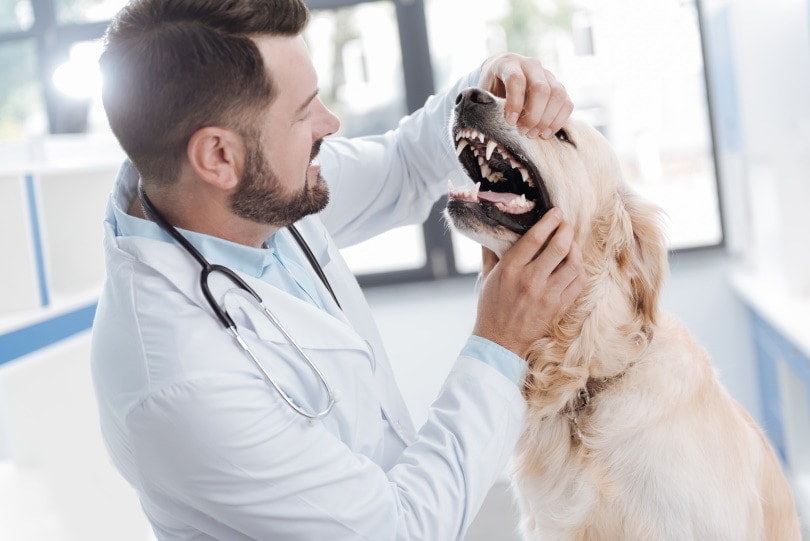Can You Use Hydrogen Peroxide on Dogs for Cleaning Wounds? (Vet Answer)

Updated on
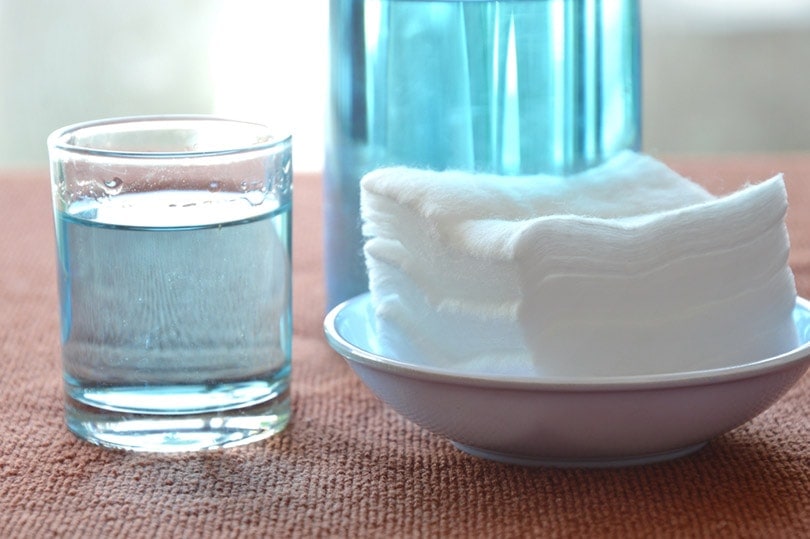
Click to Skip Ahead
Hydrogen peroxide is considered one of the most common disinfectants in the world. This solution has been used by people to clean superficial wounds due to its antibacterial properties. However, most veterinarians do not recommend using hydrogen peroxide on dogs due to potential skin irritation, inflammation, or risk of chemical burns.
Some dogs may lick it off or accidentally ingest hydrogen peroxide, which can lead to a stomach upset, vomiting, diarrhea, or, in some cases, respiratory difficulties. If your dog has a wound of any size, you should take them to the vet.
In the case of open wounds, the direct or frequent use of hydrogen peroxide to clean the area can lead to the damage and necrosis of the tissues. Therefore, it’s important to consult with a vet, as some wounds may need suturing, and it’s better to use warm water or a saline solution. Hydrogen peroxide can delay the healing process.
In this article, you will learn why hydrogen peroxide is not ideal for cleaning your dog’s wound and alternatives that you can use safely instead.
Why Hydrogen Peroxide Is Not Ideal for Cleaning Your Dog’s Wound
Hydrogen peroxide is composed of two elements, hydrogen and oxygen, with its chemical formula being H2O2. It has disinfectant, antiviral, and antibacterial properties, depending on the concentration. During external use on your dog’s skin, this solution exerts its oxidizing activity and produces free radicals, which can lead to oxidative damage to proteins and lipids. In turn, it can inactivate and destroy pathogens and prevent the spread of infection. Moreover, it also helps remove the dirt from the wounds.1
However, hydrogen peroxide can slow down the healing process. When it kills pathogens, it may also damage the body’s cells that it relies on for healing, or cause irritation or even a chemical burn. For this reason, treating wounds with hydrogen peroxide is not recommended.
It’s important to seek veterinary attention if your dog has any type of wound. They may require an Elizabethan collar to prevent licking if they can reach the wound, and some wounds need suturing or topical and systemic antimicrobial treatment and pain killers. A dog’s wound should be cleaned and flushed from all the debris before being disinfected. After debris and dirt are removed, the wound is disinfected using appropriate vet-approved solutions.
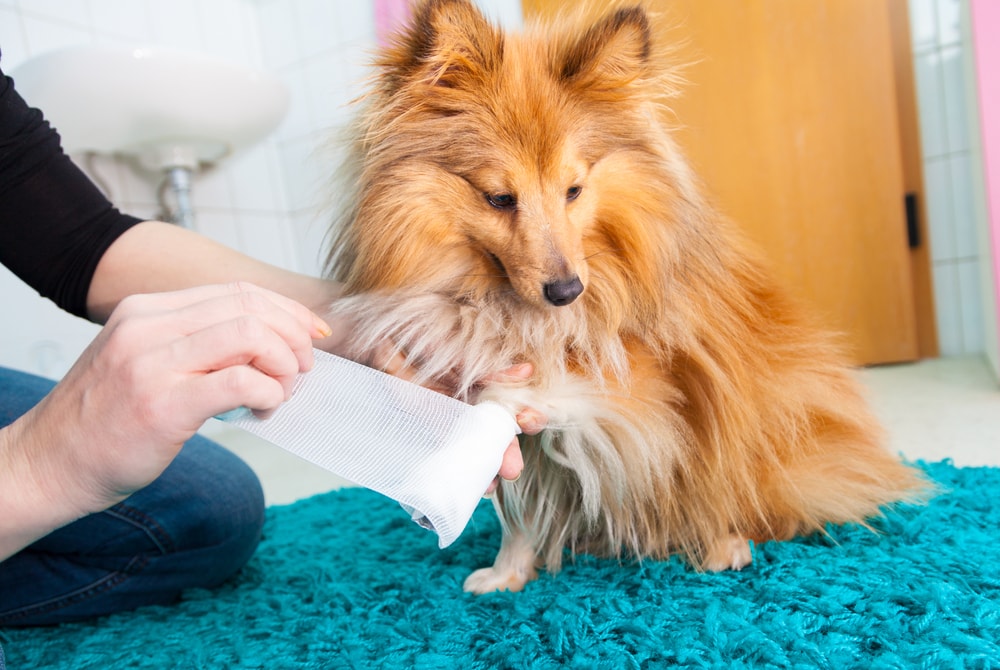
Alternatives to Hydrogen Peroxide for Cleaning a Dog’s Wound
Your vet will clean your dog’s wound and give you detailed instructions on how to manage the wound at home. For some wounds, you may not need to do anything. For others, the vet will show you how to keep them clean, which products to use, and how often to apply them. Even if a wound seems small and superficial, it’s good to get it checked by your vet.
Saline Solution
This solution does not burn or irritate the skin and is often used for wound flushing. You can use a simple saline solution or saline wound wash, if recommended by your vet, or prior to your appointment. You can even use saline eyewash if that’s what you have in your home. The best thing about this solution is that it won’t cause any discomfort to your dog.
If you don’t have saline solution at home, you can prepare it yourself. Add 1 teaspoon of salt, which equals 5 milliliters, to 500 milliliters of water. You can use normal salt or Epsom salt.
If the wound is deep or bleeding continuously, contact the veterinarian immediately and apply a pressure bandage to stop the bleeding and protect the wound from further damage and contamination. It is recommended to contact the veterinarian even if your dog’s wound is not deep or bleeding. They may recommend preparing a dilute solution of chlorhexidine or iodine to help remove debris and disinfect your dog’s wound.

Dawn Dish Soap
If your dog has oil or grease near the wound, a mild soap such as Dawn may be used to degrease the area. Do not use Dawn dish soap directly on the wound. Avoid the wound, or use sterile water-soluble lubricant and cover it with gauze to protect it. Rinse the wound with a saline solution or warm water.
Avoid Shampoo, Soaps, or Rubbing Alcohol
Don’t use shampoo, rubbing alcohol, or other products that contain alcohol or perfume because they can be irritating and uncomfortable to your dog. These can slow or prevent healing and be toxic if your dog licks them. Additionally, shampoos require additional rinsing, which can make handling your dog’s wound painful for your pet.
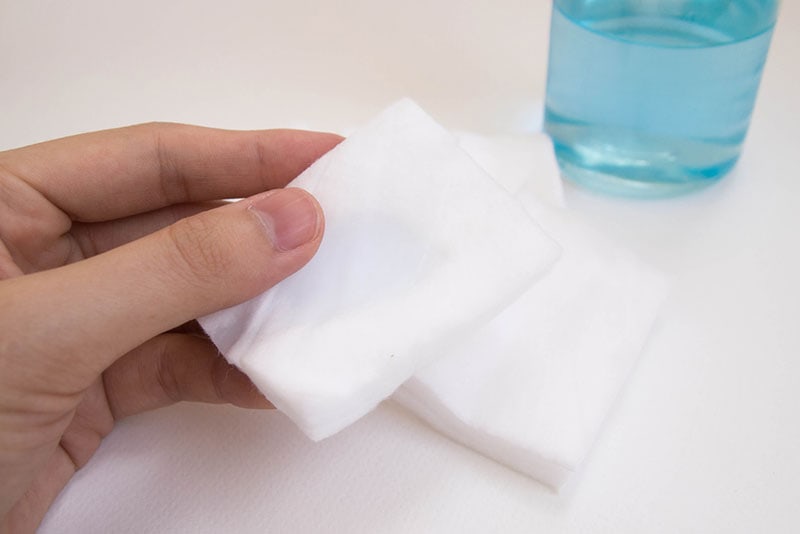
When Is It Okay to Use Hydrogen Peroxide?
In veterinary medicine, hydrogen peroxide may still have a few uses, although other products have started to replace it in most countries. Some may still use it due to a lack of other available products, to flush superficial wounds, or to wash/clean drain tube exit sites or pets’ fur due to its oxidizing effect.
Hydrogen peroxide should only be used by veterinary professionals and under their instructions. The most common concentration is 3%, and anything more concentrated is very irritating and should not be used. Hydrogen peroxide is considered to have limited antiseptic effectiveness and short antimicrobial action, while its wound-cleaning mechanism is mechanical due to the release of oxygen.
Hydrogen peroxide has also been used to induce vomiting if your dog has been poisoned or intoxicated, but only under a vet’s supervision. There are safer and more appropriate veterinary drugs used for this purpose today. In some cases, inducing vomiting in dogs is contraindicated because it can cause burning of the digestive tract, as it happens with corrosive substances, or it may damage the esophagus in case of sharp objects. In addition, vomiting can lead to aspiration pneumonia, which can be life-threatening if not intervened in time.
If your dog consumes a poisonous substance, plant, or foreign body, contact a veterinarian immediately. Poisoning can be fatal for dogs or lead to serious health consequences if not attended to in time. If you cannot contact the veterinarian, call a dedicated pet poisoning hotline. Do not induce vomiting at home, particularly without first talking to a specialist.
You can also use an appropriate solution of hydrogen peroxide to remove dried blood from fabrics, such as dog clothes or textile collars. Soak the blood-stained material in hydrogen peroxide and rinse well.
If your dog has blood on their fur or other biological fluids, you can use hydrogen peroxide to clean the area, but make sure your dog doesn’t lick it off. Apply hydrogen peroxide on your pet’s fur and let it sit for 1–2 minutes, then wipe or comb your dog’s fur and rinse any remaining peroxide.
How to Tell if Your Dog’s Wound Is Healing
Regardless of the type of wound or the amount of tissue lost, the healing process goes through three dynamic stages:
- Cleaning phase
- Granulation phase (tissue formation)
- Epithelialization phase
In the case of chronic wounds (i.e., those that do not show visible signs of healing in an acceptable period of time even if they have been adequately treated), this healing process is disrupted, and tissue regeneration is delayed.
When the wound is healing, you may notice a pink color of the new tissue and the formation of a scab. Over time, you will observe how the wound becomes smaller, and the skin turns smooth and pink.
If there is worsening redness, inflammation, discharge, a bad smell, the wound seems to be opening up, or the dog is licking it, they will need to be seen by the vet as soon as possible.
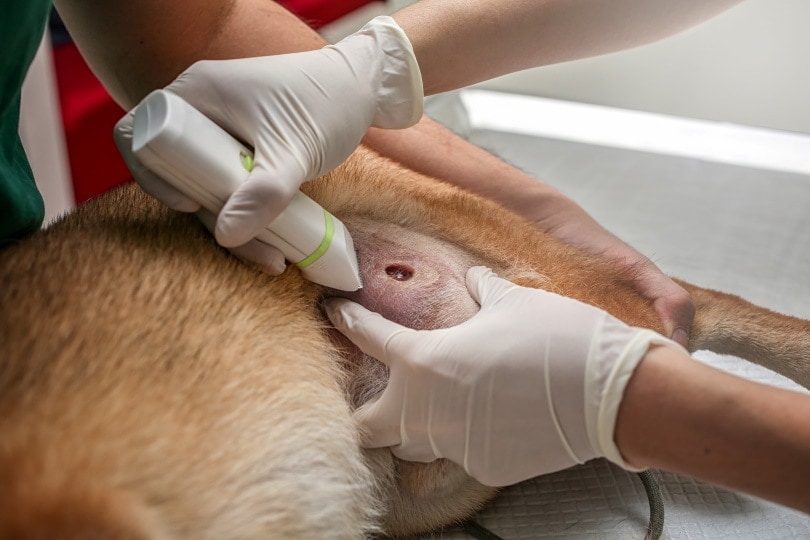
How Long Does It Take for a Wound to Heal?
It is vital to allow a wound to heal completely before engaging in any activity with your dog that will cause poor or impaired wound healing or further complications. It can take anywhere from a few days to several weeks for a wound to heal, depending on the severity, size, and treatment.
The healing process depends on several factors, such as:
- The size and depth of the wound
- The age of your dog
- Your dog’s health or ongoing medication
- The initial degree of infection (if applicable)
- Location of the wound
- Licking
If a wound is fresh (not old) and is properly cleaned and treated by your vet (including surgical intervention if needed), the healing process can take up to 2 weeks.
An old wound may take 4–6 weeks, depending on the severity and how well it was cleaned and managed. In the case of severe wounds that cannot be closed surgically at all or only partially or that need repeat surgeries, the healing process can take several months.
Conclusion
It is best to avoid using hydrogen peroxide on your dog’s wound because it can lead to inflammation, irritation, chemical burns, and/or tissue damage, especially if it is used too often or in an inappropriate concentration. Dogs may lick it or ingest it, leading to a stomach upset. Always follow your vet’s instructions when managing a wound and get any wound checked out by the vet.
Alternatives are a saline solution or warm water; soaps, shampoos, herbal products, etc. can irritate the skin and slow down the healing process and may be harmful if ingested. If you need to remove blood stains from your dog’s fur or fabrics, hydrogen peroxide may be a suitable product. Do not use it to induce vomiting in your dog, as it may not be appropriate or safe, and speak to your vet or the veterinary poisons hotline if you believe your dog has ingested a toxic substance or a foreign material.
Featured Image Credit: pedphoto36pm, Shutterstock





